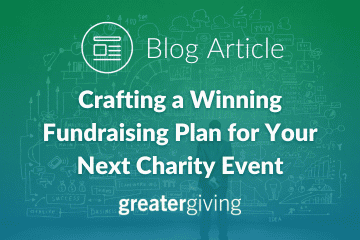
Elevate Your Impact: Crafting a Winning Fundraising Plan for Your Next Charity Event
As a nonprofit professional, you understand the importance of effective fundraising. A well-crafted fundraising plan can be the difference between exceeding your goals and falling short. But where do you begin? This blog post outlines the key elements for creating a successful fundraising plan for your next charity event, empowering you to maximize your impact.
Setting the Foundation: Mission and Goals
Mission:
Start by clearly defining your mission statement. This succinctly expresses the purpose of your event and aligns with your organization’s overall mission.
Example: “To raise critical funds through a community gala to support our after-school literacy program for underprivileged children.”
Goals:
Establish specific, measurable, achievable, relevant, and time-bound (SMART) goals for your fundraising plan. These goals should be both financial (e.g., raising $10,000) and non-financial (e.g., increasing donor base by 20%).
Example: “Raise $10,000 to purchase new books and educational materials for the program. Attract 100 new individual donors and secure corporate sponsorships from 5 local businesses.”
Charting the Course: Tactics and Strategies
Tactics
Identify engaging fundraising tactics aligned with your mission and goals. This could include:
- Corporate sponsorships
- Ticket sales for a gala dinner or auction
- Live Auction
- Silent Auction
- Revenue Enhancers, like a wall of wine or heads and tails
- Fund-A-Need
Strategies:
Develop clear and detailed strategies for implementing each tactic. These strategies should address:
- Target audience identification- Develop an email and/ or mailing list for tickets and sponsorships
- Selling Tickets online and through direct mail
- Marketing and promotion plan
- Volunteer recruitment and management
- Logistics and execution plan
Example: “Launch a social media campaign to promote the event and engage potential donors. Partner with local media outlets to secure publicity. Recruit a volunteer team to manage registration, ticket sales, and event logistics.”
Financial Roadmap: Creating a Budget
Develop a realistic budget that outlines all event-related expenses (e.g., venue rental, catering, entertainment) and anticipated revenue (e.g., ticket sales, sponsorships). You can also keep track of revenue and expenses within the Greater Giving System.
Example: Budget for the “Literacy for All Gala” might include:
* Expenses: Venue rental ($2,000), catering ($5,000), entertainment ($1,000), Decor (4,500), AV ($4,000), photography ($2,500)
* Revenue: Ticket sales ($12,000), Sponsorships ($35,000), Live Auction ($45,000), Silent Auction ($10,000), Revenue Enhancers ($4,500), Special Appeal ($25,000)
Staying on Track: Establishing a Timeline for Your Fundraising Plan
Download our Fundraising Guide Checklist for a timeline that outlines all key milestones and deadlines for planning and execution.
Example:
* 3 months before: Complete the design and printing of your formal event invitation.
* 1 month before: Meet with your volunteer committee to review list of those volunteering on event night. Revisit the volunteer roles list and assignments. Conduct a status check on volunteer recruitment and work assignments.
* 1 week before: Confirm speakers—emcee, special appeal speaker/s. Review the event night timeline and script in detail at your program rehearsal.
Remember, a successful fundraising plan is a dynamic document. Monitor progress, track key metrics, and be prepared to adapt your strategies as needed. By following these key elements, you can create a winning fundraising plan that propels your charity event to new heights!
